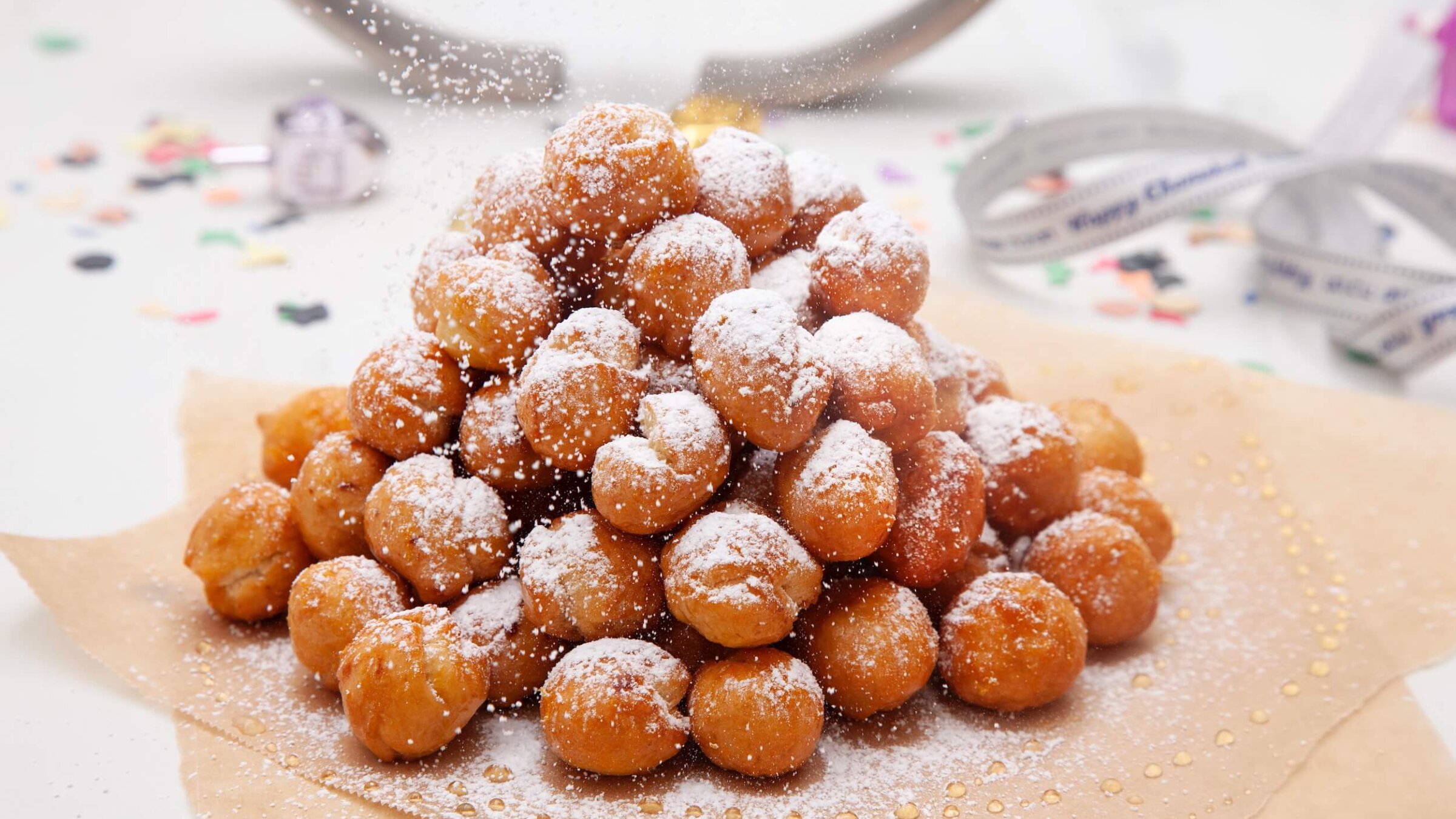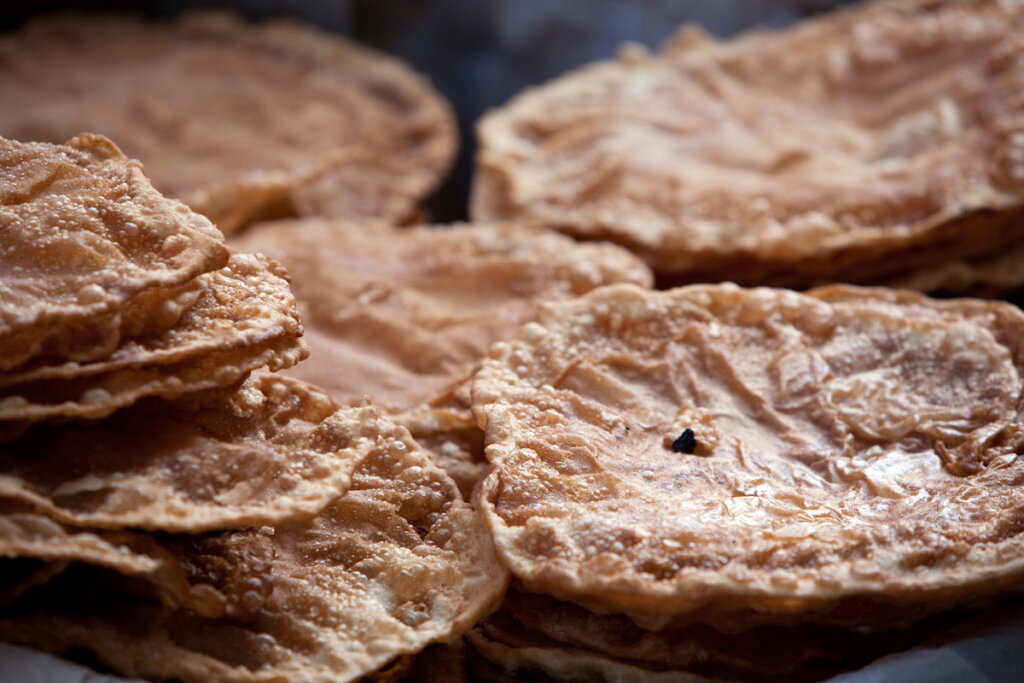Celebrating Chrismukkah? There’s a food for that.
That traditional Christmas dish you’re serving might just be Jewish

Silvia Nacamulli, author of ‘Jewish Flavours of Italy,’ said her Hanukkah precipizi-struffoli is “essentially a marriage” of Jewish and Catholic desserts. Photo by Inbal Bar Oz
The first night of Hanukkah falls on Christmas Day this year, posing a dilemma to interfaith families: What’s for dinner?
Do you go all-in on traditional Christmas foods — roast goose, tamales, or, gasp, baked ham — or do you lay out your grandmother’s traditional Hanukkah recipes — latkes, brisket, jelly donuts, and definitely not ham?
There is, actually, another choice: Set a table with foods that have a shared Jewish and Christian past.
We tend to think in strict categories, but the thing I love most about food, aside from cooking and eating it, is how it transcends barriers. Food wants to be shared, borrowed, adapted — and eaten.
Take buñuelos, the traditional Mexican Christmas dessert of rich fried dough dusted with sugar and dotted with jam — which is also common among the Jews of Spain.
The recipe for buñuelos that appears in Ilan Stavans’s must-read new cookbook, Sabor Judio: The Jewish Mexican Cookbook, comes from Juana Ines de la Cruz, a nun who lived in the 17th century in a convent near Mexico City, and whom Mexicans to this day revere as a poet and philosopher.
“She is the Emily Dickinson of Mexico,” Stavans told me during a Zoom call. “As big as Frida Kahlo.”
De la Cruz was the descendant of conversos, Jews forced to convert by the Inquisition. Inside the convent, she kept meticulous notes on the dishes she cooked, eventually compiling a recipe book.
“Her making the buñuelos really is like a Jewish food wrapped inside of Catholicism,” Stavans said.
I asked Stavans what it means that a Mexican Christmas staple has roots among the Jews of Spain.
“It means the ancestry of Mexico includes many, many Spanish Jews that were running away from the Inquisition in Spain and looked at Mexico as a safe haven,” he said.

Serving a fried dessert is an ancient Hanukkah tradition, intended to recall the miracle of the oil that burned in the Temple of Jerusalem for eight days instead of the expected one. In Cookbook of the Jews of Greece, Nicolas Stavrolakis writes that a fried donut-like pastry called loukoumades, which Greeks to this day cook for Christmas, are the Christian version of what Sephardic Jews also call bimuelos, and Romaniote Jews called zvingous.
For centuries, Christians slandered Jews as Christ-killing moneylenders, even forcing them to convert or be killed. But it couldn’t keep the fragrance of their fried Hanukkah donuts out of the neighborhood air.
Meanwhile, in Sicily, Jews fried pancakes made from cheese for Hanukkah, the original latkes. They also crafted cakes from whey. These cheesecakes, with the addition of sugar brought by the Arabs, became cassata, a Sicilian Christmas and Easter tradition. (The Jews made it for Purim and Shavuot.) When the Sicilian Jews were expelled by the Inquisition and escaped north to Rome, they made a variation called the cassola, which, as Joan Nathan writes in her King Solomon’s Table: A Culinary Exploration of Jewish Cooking from Around the World, “is a Christmas staple.”
Salted cod dipped in batter and deep-fried, or filetto di baccalà, was another Jewish dish — still on offer, and still delicious, in the historic Roman Jewish ghetto today — which many Italian Catholics serve as part of the traditional Feast of the Seven Fishes Christmas meal.
But there’s an even better example of food intermarriage at the Italian holiday table: the joyful little honey-drenched donuts called precipizi-struffoli.
“It’s essentially a marriage of two desserts — one Jewish and one Catholic — that likely influenced each other,” Silvia Nacamulli, the author of Jewish Flavours of Italy, wrote in an email.
Precipizi are a Hanukkah dessert from Ancona in Central Italy. Nacamulli makes hers olive-sized and piled into a pyramid, similar to struffoli, a Neopolitan Christmas dessert.
“I’d be surprised if there isn’t some historical connection between them,” Nacamulli wrote.
I would be too, because that’s the way food works. Where Jews landed, they cooked, sharing recipes and traditions with their Christian neighbors — and vice versa. Sabor Judio has a recipe for latkes con mole, the rich Mexican sauce of indigenous origin, which Stavans told me is increasingly common at Mexican Janucá parties.
Sometimes, as with buñuelos and baccala, the connections to the Jewish past are clear. And sometimes they’re lost to history — but close enough to suspect.
In Provence, it’s traditional to end a Christmas meal with a variety of dried fruits and nuts — the same way Sephardic Jews end a New Year’s meal. I asked Nathan, who wrote the definitive cookbook on the foods of French Jewry, if it were possible that this Provencal Christmas tradition had Jewish roots.
“Provence was so Jewish,” she said, pointing out the first Jews arrived in the 1st century C.E., and thousands more came during the Inquisition.
And then there’s eggnog. A century before the first mention of eggnog as a holiday beverage, Ashkenazic Jews were drinking gogle mogl, a concoction of egg yolks, warm milk, honey, cinnamon and (optional) brandy, “across the Yiddish-speaking world,” according to Eve Johnowitz, a culinary historian. They didn’t drink it for Hanukkah, but to ward off colds and sore throats. (In the 20th century, Barbra Streisand’s mother pushed it on her daughter to protect her voice.)
That doesn’t exactly tell you who first decided to drink hot egg yolks. But it does make you wonder.
It’s a stretch to claim absolute ownership over recipes whose actual origins are in the distant past. But at a time when entire server farms are devoted to social media battles over who has the right to make hummus or what culture is appropriating whose food, these Hanukkah-Christmas food connections remind us that deliciousness disregards politics and prejudice.
If you’re a family looking for an authentically interfaith holiday meal, you could fashion an entire menu around these foods, which tell stories of persecution and exile, but also of resilience and sharing.
Or you could, you know, just order Chinese.

















